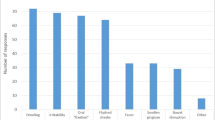Abstract
Aim
Despite many advances in paediatric dentistry, the greatest challenge for any paediatric dentist is to remove the anxiety related to a dental visit and have a child patient to accept dental treatment readily. Minor changes made in the waiting room design can have a major effect on the way any child perceives the upcoming dental experience. This study was carried out to determine children’s preferences regarding the dental waiting area so as to improve their waiting experience and reduce their preoperative anxiety before a dental appointment.
Study design
This was a cross-sectional descriptive study using survey methodology.
Methods
A questionnaire designed to evaluate children’s preferences regarding the waiting room was distributed to new paediatric patients, aged between 6 and 11 years of age, attending an outpatient dental facility and was completed by 212 children (127 males, 85 females).
Statistics
The analyses were carried out on cross-tables using Phi (for 2 × 2 tables) or Cramer’s V (for larger than 2 × 2 tables) to assess responses to the questionnaire items across age groups and gender.
Results
A majority of children preferred music and the ability to play in a waiting room. They also preferred natural light and walls with pictures. They preferred looking at an aquarium or a television and sitting on beanbags and chairs and also preferred plants and oral hygiene posters Repetious.
Conclusions
The results obtained from this study may help the dental team decide on an appropriate design of their paediatric waiting room so as to make children comfortable in the dental environment and improve delivery of health care.



Similar content being viewed by others
References
Aitken JC, Wilson S, Coury D, Moursi AM. The effect of music distraction on pain, anxiety and behavior in paediatric dental patients. Pediatr Dent. 2002;24(2):114–8.
Al Sarheed M. Children’s perception of their dentists. Eur J Dent. 2011;5:186–90.
Becker F, Douglass S. The ecology of the patient visit: physical attractiveness, waiting times, and perceived quality of care. J Ambul Care Manag. 2008;31(2):128–41.
Benedetti F, Colombo C, Barbini B, Campori E, Smeraldi E. Morning sunlight reduces length of hospitalization in bipolar depression. J Affect Disord. 2001;62(3):221–3.
Brase GL, Richmond J. The White–coat effect: physician attire and perceived authority, friendliness, and attractiveness. J Appl Soc Psychol. 2004;34:2469–81.
Charnock C. Swabbing of waiting room magazines reveals only low levels of bacterial contamination. Br J Gen Pract. 2005;55(510):37–9.
Cimbalo RS, Beck KL, Sendziak DS. Emotional toned pictures and color selection for children and college students. J Gen Psychol. 1978;133:303–4.
Cooke M, Chaboyer W, Schluter P, Hiratos M. The effect of music on preoperative anxiety in day surgery. J Adv Nurs. 2005;52(1):47–55.
Daniel WW. Biostatistics: A Foundation for Analysis in the Health Sciences. 7th ed. New York: Wiley; 1999.
da Silva Pedro IC, Nascimento LC, Poleti LC, et al. Playing in the waiting room of an infant outpatient clinic from the perspective of children and their companions. Rev Lat Am Enferm. 2007;15(2):290–7.
Diffey BL, Storey A. Light and length of stay in hospital. J R Soc Med. 1988;81(11):643.
Eisen SL, Ulrich RS, Shepley MM, Varni JW, Sherman S. The stress-reducing effects of art in paediatric health care: art preferences of healthy children and hospitalized children. J Child Health Care. 2008;12(3):173–90.
Fitzgerald RP, Thomson WM, Schafer CT, Loose MA. An exploratory qualitative study of Otago adolescents’ views of oral health and oral health care. N Z Dent J. 2004;100(3):62–71.
Holm L, Fitzmaurice L. Emergency department waiting room stress: can music or aromatherapy improve anxiety scores? Pediatr Emerg Care. 2008;24(12):836–8.
Inglehart MR. Interactions between patients and dental care providers: does gender matter? Dent Clin North Am. 2013;57(2):357–70.
Jafarzadeh M, Arman S, Pour FF. Effect of aromatherapy with orange essential oil on salivary cortisol and pulse rate in children during dental treatment: a randomized controlled clinical trial. Adv Biomed Res. 2013;2:10.
Katcher A, Segal H, Beck A. Comparison of contemplation and hypnosis for the reduction of anxiety and discomfort during dental surgery. Am J Clin Hypn. 1984;27(1):14–21.
Lehrner J, Eckersberger C, Walla P, Pötsch G, Deecke L. Ambient odor of orange in a dental office reduces anxiety and improves mood in female patients. Physiol Behav. 2000;71(1–2):83–6.
McKahan DC. Healing environments: healing by design-therapeutic environments for healthcare. J Healthc Des. 1993;5:159–66.
Megel ME, Houser CW, Gleaves LS. Children’s responses to immunizations: Lullabies as a distraction. Issues Compr Pediatr Nurs. 1998;21(3):129–45.
Nanda U, Chanaud CM, Brown L, Hart R, Hathorn K. Paediatric art preferences: countering the “one-size-fits-all” approach. HERD. 2009;2(4):46–61.
Park JG. Color perception in paediatric patient room design: healthy children vs. paediatric patients. HERD. 2009;2(3):6–28.
Park SH, Mattson RH. Ornamental indoor plants in hospital rooms enhanced health outcomes of patients recovering from surgery. J Altern Complement Med. 2009;15(9):975–80.
Parkin SF. The effect of ambient music upon the reactions of children undergoing dental treatment. ASDC J Dent Child. 1981;48(6):430–2.
Pati D, Nanda U. Influence of positive distractions on children in two clinic waiting areas. HERD. 2011;4(3):124–40.
Sandberg DE, Meyer-Bahlburg HF, Ehrhardt AA, Yager TJ. The prevalence of gender-atypical behavior in elementary school children. J Am Acad Child Adolesc Psychiatry. 1993;32(2):306–14.
Umamaheshwari N, Asokan S, Kumaran TS. Child friendly colours in a paediatric dental practice. J Indian Soc Pedod Prev Dent. 2013;31(4):225–8.
Ward K, Hawthorne K. Do patients read health promotion posters in the waiting room? A study in one general practice. Br J Gen Pract. 1994;44(389):583–5.
Weber FS. The influence of playful activities on children’s anxiety during the preoperative period at the outpatient surgical center. J Pediatr (Rio J). 2010;86(3):209–14.
Author information
Authors and Affiliations
Corresponding author
Rights and permissions
About this article
Cite this article
Panda, A., Garg, I. & Shah, M. Children’s preferences concerning ambiance of dental waiting rooms. Eur Arch Paediatr Dent 16, 27–33 (2015). https://doi.org/10.1007/s40368-014-0142-z
Received:
Accepted:
Published:
Issue Date:
DOI: https://doi.org/10.1007/s40368-014-0142-z



